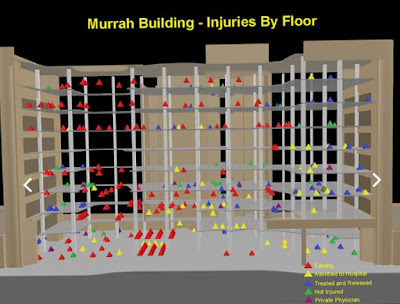Uncertain Health in an Insecure World
– 79
“Dark Chambers”
Vaporization
of human tissues is hard to imagine, even for combat-hardened veterans and emergency
first responders.
After
centuries of reliance on low-grade black powder for musketry and firecrackers, the era of high-grade explosives
began with the invention of dynamite by Alfred Nobel in 1867 (below, based on nitroglycerine).
Nobel bequeathed his fortune to an eponymous prize, after reading a premature
obituary condemning him as an arms dealer.
Other deadly
innovations followed.
When a solid
or liquid is rapidly converted to a gas, the sudden release of energy is either
a flash (deflagration) or a bang (explosion), or both. Detonation of a high-grade
explosive produces a supersonic ignition and blast wave – the resulting noise
is a localized sonic boom.
The pressure
released by a blast creates shock waves (below) that instantaneously exceed atmospheric
pressure (over-pressure). The shear
force between propagating wave peaks is highly destructive, as is the subsequent
spalling which sheds small fragments internally
from the impact surface, even without physical penetration.
The most
common cause of American military casualties treated at Walter Reed Army
Medical Center since 2006 was blast injuries from improvised explosive devices
(IED’s) in Iraq and Afghanistan. In the modern terrorism era, high-grade
explosives have frequently been used in domestic attacks on non-combatants.
The sad long list grows every year:
The sad long list grows every year:
· 1995 Alfred Murrah Building bombing in
Oklahoma City (ammonium nitrate),
· 7/7/2005 London Underground attack (tri-acetone
tri-peroxide, TATP),
· Patriot’s Day 2013 Boston Marathon
finish line IED’s (below, made from a pressure cooker with a blasting cap).
Miraculously,
nineteen year-old Mormon missionary Mason Wells (below) escaped unscathed from the
Boston Marathon bombing and the ISIS-inspired Nov. 13, 2015 Paris attack, only
to fall victim to the March 22, 2016 bombing at the Brussels airport. A terrorist
detonated his TATP device less than 50 feet away from Wells, who recounted, “My body got really hot and then really cold... I was covered in a lot of fluids, a lot of
blood – not necessarily mine.”
Casualties
of such bombs are characterized by three concentric blast zones: the epicenter
(kill zone), the secondary perimeter (critical casualty zone) and the periphery
(walking wounded zone). The human destruction associated with the addition of
nails, screws (below) and ball bearings to the explosive device causes carnage beyond belief,
by intent.
The capacity
to launch a shell at an enemy position miles away, to dig an IED into a
roadside and detonate it, or even to drop a bomb from an airplane into a
civilian neighborhood pales in comparison to the up-close and personal nature
of a suicide bomber attack on a public gathering place – a so-called soft
target.
Like many of
you, I have ridden on a double-decker bus through the streets of London (above) and strolled
the streets of Paris. Like some of you, I have run across the finish line of
the Boston Marathon. Like a very few of you, I flew into Oklahoma City the day
the Murrah building (below) was destroyed, seeing dense black smoke rise from downtown
as we landed.
Terrorists
are not warriors. They inflict fear among the peaceful masses, by murdering an
unlucky few.
In the words
of veteran Iraq war correspondence,
Michael Ware (above), “Certain dark chambers of
the heart, once opened, can never be closed again.”
A merciful
God will grant Mason Wells amnesia regarding the cool liquid that drenched his
burned skin – body fluids from an ISIS-inspired suicide bomber.
“Allahu
Akbar”… Really?
We in the
Square continue to live with, and some of us will die from, this sad reality.
The main
casualty of such brutality is humanity.












No comments:
Post a Comment